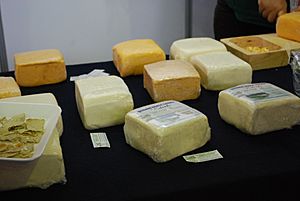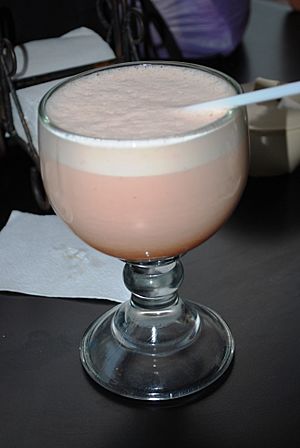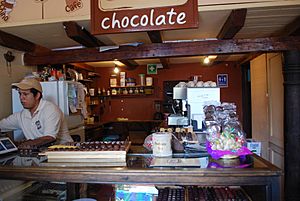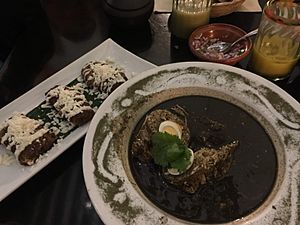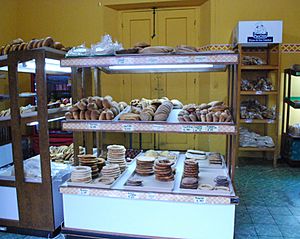Cuisine of Chiapas facts for kids
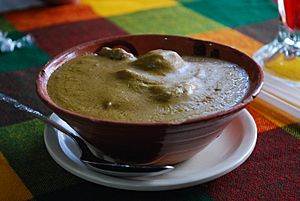
The cuisine of Chiapas is a special way of cooking from the Mexican state of Chiapas. Just like most Mexican food, it uses a lot of corn. It also mixes old traditions from the native people with ideas from Europe. What makes Chiapas food unique is how much it still uses old native ingredients. For example, they use an herb called chipilín in their tamales and soups. You won't find this herb used in other parts of Mexico!
Even though Chiapas food uses some chili peppers, like the very hot simojovel, it doesn't use them as much as other Mexican foods. Instead, many main dishes have a slightly sweet taste. Chiapas has big areas perfect for raising animals. So, the food often includes meat, especially beef, and lots of cheese. The most important dish is the tamal, with many different kinds made across the state. Other popular dishes include chanfaina, which is like a stew, and sopa de pan (bread soup). While Chiapas has tried to share its food with tourists, it's not as famous as food from places like Oaxaca.
Contents
What's in Chiapas Food?
Chiapas cooking is a blend of native and Spanish ingredients. It still uses many native plants. For example, chipilín is a leafy herb often found in tamales and soups. Another common herb is hoja santa, used in many dishes in southern Mexico.
The main ingredient is corn, which is a very old food in this region. You'll find corn in tortillas and tamales. It's also used to make different drinks. Other native ingredients include chili peppers, cacao beans (used for chocolate!), beans, avocados, and an edible flower called “cuchunuc.” People also eat wild plants like radishes, mustard, and different kinds of mushrooms. Cacaoite is a seed ground up with squash seeds to make sauces. In the countryside, people still eat meats from wild animals like armadillo and wild boar. Chiapas food often uses black beans. They are usually cooked simply with salt and chili, without much fat.
After the Spanish arrived, new ingredients were added. The Spanish brought meats like beef, pork, and chicken. Beef became very popular. Many parts of Chiapas are great for raising cattle. Since the time of the Spanish, raising cows and sheep has been a big part of the economy. One famous beef dish is grilled strips called tasajo, served with different sauces.
Raising cattle also led to a cheese industry. Most cheese is still made on farms. Important cheese-making areas are Ocosingo, Rayón, and Pijijiapan. The round white cheeses from Ocosingo are well-liked across Mexico. In colder parts of the state, people make cured meats. New crops like coffee, soybeans, and many tropical fruits were also introduced.
Chiapas food doesn't use as many chili peppers as other Mexican foods. Chilies mostly appear in sauces or side dishes. Some local chilies include the “chile de siete caldos,” which is very strong, and the simojovel, which is too hot to use a lot of. Chiapas dishes often have a slightly sweet taste. They use ingredients like tomatoes, cinnamon, plantains, prunes, and pineapple. For example, the Chiapas version of chile relleno (stuffed chili) can include peas, almonds, peaches, and dried pineapple.
Some other countries have also influenced Chiapas food. Germans, English, French, and Asians moved here after the Spanish. Germans helped start the coffee industry and introduced beer and cured meats in some areas. Coffee is a very important crop in the Soconusco area. Much of it is sent to other countries and brings tourists to the region.
Today, common farmed foods in Chiapas include squashes, potatoes, fava beans, chayote, cabbage, cucumbers, sweet potatoes, and many fruits like mango, papaya, sapodilla, soursop, cherimoya, and mamey sapote.
Yummy Dishes to Try!
The most famous and popular dish in Chiapas is tamales. You can find many different kinds! The main herbs of Chiapas, chipilín and hoja santa, are often used in these tamales. Most tamales are wrapped in banana leaves, but some are wrapped in corn husks or even hoja santa leaves. Popular types include jacuané (with hoja santa), de bola (pork in chili sauce), and tamales with turtle, iguana, or fish.
Another dish with many versions is chanfaina. This is a stew made from tripe, similar to menudo. Sopa de pan (bread soup) is a chicken broth with fried bread pieces added just before eating. It's a popular dish for special events in Chiapas. Other dishes include huevos de vigilia, rollitos de plátano, and pit-barbecued beef. You might also find sea bass in its own juice, rice with saffron, and black beans with salted beef.
Local drinks include pozol (a corn-based drink) in different styles. There are also sweet fruit drinks, tascalate, atole, and hot chocolate. The main alcoholic drinks are made from sugar cane. These include fermented sugar cane drinks and aguardiente, which is a strong spirit.
Food from Different Areas
Different parts of Chiapas have their own special foods. The state has eighteen recognized native groups, many of them from the Mayan culture. One well-known group is the Lacandones, who live in the rainforest. Most of their food is based on corn, cooked in different ways. They also eat wild mushrooms and drink a fermented drink called balché.
The Zoques, who live in the northwest, are known for eating a small freshwater snail called chuti. These snails are usually gathered in the spring from streams. They are often cooked in a broth flavored with hoja santa, then thickened with corn dough. The snails are also eaten as a snack in Tuxtla Gutierrez. Another unique food from this area is bee larvae.
The cultural heart of the state is San Cristobal de las Casas. This city is famous for cured meats like ham and sausages, which came from Spain. It also has native dishes like different tamales, including one with saffron. A common street food in San Cristobal is called a cazueleja. It's a roll filled with cheese, egg, and cinnamon. San Cristobal is also known for its sweets, which people often eat with coffee in the evenings. These sweets include crystallized fruit, coconut candies, and different kinds of sweet and regular breads, brought by the French.
The capital city, Tuxtla Gutiérrez, and Chiapa de Corzo across the river, have their own specialties. These include ningüijute, a pork mole made with seeds, and chispola, a beef and vegetable stew. Pictes are sweet corn tamales. Chiapa de Corzo is also known for cochito horneado, which is a roasted suckling pig with special seasoning, often made for celebrations.
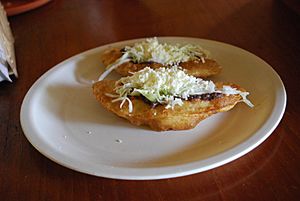
The cool highlands, including the city of Comitán, also enjoy cured meats. Comitán is known for pit-barbecued chicken and a salad made with hearts of palm. They also make a drink called comiteco, from maguey plants, and mistela, made from fruits like mango and plum.
The coastline, separated by mountains, uses seafood from the Pacific Ocean. This includes bass, grouper, shrimp, crabs, and clams. Shrimp is often dried for later use. Dried shrimp can be mixed with tomato salsa for an appetizer or used in tamales juacanes with black beans and pumpkin seeds.
Palenque is an area where cattle are raised, so it has good beef dishes. You'll also find many versions of fried plantains there, some filled with black beans or cheese.
The Soconusco area, known for its farms, has attracted people from other countries. You can find Chinese, Japanese, and German restaurants there. The most famous food in Tapachula is Chinese style, due to Chinese immigrants who arrived in the late 1800s and early 1900s.
Sharing Chiapas Food with the World
Most Chiapas cooking is simple, everyday food. It's not as fancy or complex as the food from neighboring Oaxaca. The cuisine of Chiapas is not as well-known as food from Oaxaca, Puebla, or Michoacán.
However, famous chefs like Rick Bayless have helped share Chiapas food with people around the world. Since the 1990s, the state of Chiapas has worked to promote its food. They do this through events, media, and cooking groups. The state has even said that its cuisine is an important part of its heritage and helps with sustainable tourism. They sponsor food festivals, like the Festival de la Autentica Cocina Chiapaneca, and cooking contests for chefs using traditional ingredients. One of these is the Alta Cocina Regional y de Author de Chiapas, started by chef Marta Zepeda.
See also
 In Spanish: Gastronomía de Chiapas para niños
In Spanish: Gastronomía de Chiapas para niños


